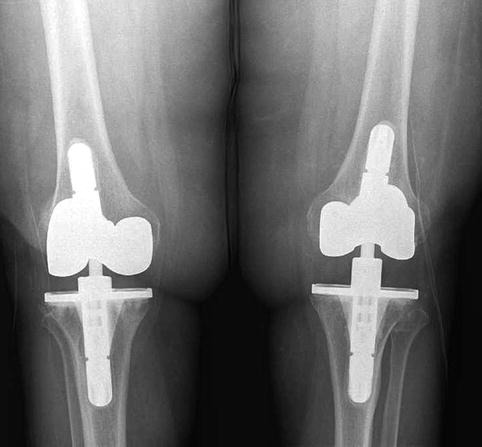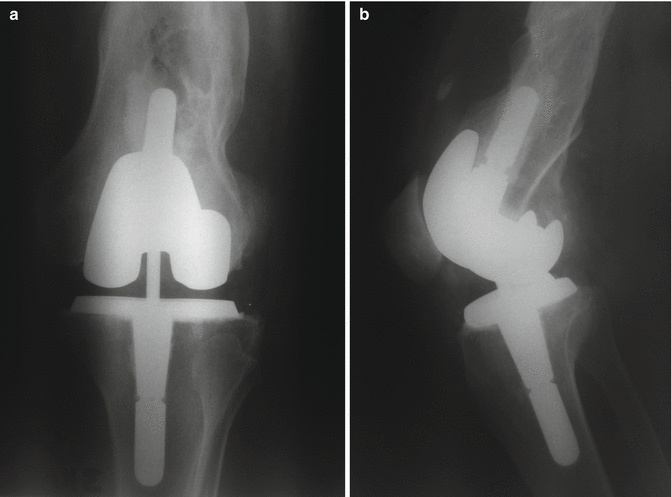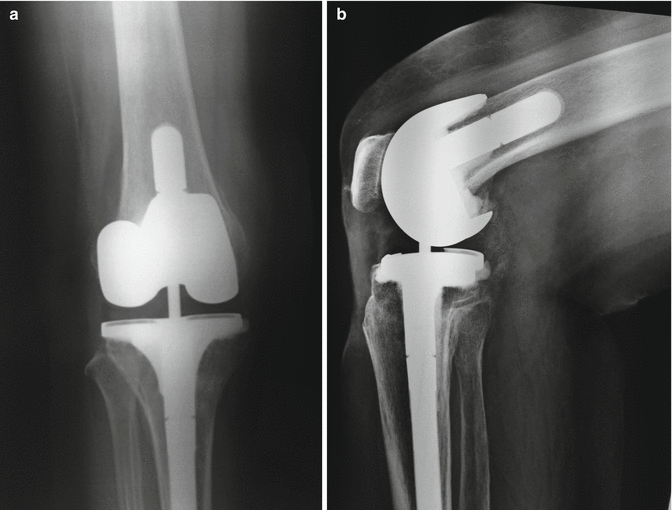Fig. 18.1
Condylar Constrained Implant. A tall tibial post articulates in the intercondylar femoral box. 1.2° of valgus/varus and 2–3° of rotation are allowed in this particular implant. Most implants are fully constrained in both axes (Courtesy of BIOMET)
In a non- or semi-constrained design, forces generated in the knee joint during walking are counter balanced and absorbed by the soft tissue envelope in a way that resembles normal knee function. As the degree of constraint increases the amount of force absorbed by the implant rather than the soft tissues is increased and transmitted to the bone implant interface in the form of shear forces. Early loosening of constrained, first generation hinge implants was thus attributed to increased shear forces being transferred to the interface. Although condylar constrained devices of first and second generation are based on a totally different design philosophy, fears that increased shear forces will cause early loosening made the use of long stems mandatory. In recent years, concerns have been raised about the need for such stems. Their contribution to long term stability of the implant has been challenged and a number of drawbacks have been highlighted, such as the difficulty of removing these stems (especially cemented ones), the risk of diaphyseal fractures and increased cost. It seems reasonable, based on some latter reports, that CCK implants can be used either with very short stems or even without in cases with good bone quality. Controversy also exists concerning the use of cement for fixation of the stems. While femoral and tibial prostheses are cemented in almost all CCK TKAs, most contemporary knee systems offer a choice between cemented and uncemented stems. Traditional long cemented stems have proved extremely difficult to revise, especially in cases of infection where complete removal of the cement is mandatory. Proponents of uncemented stems believe that these stems are easier to remove, although more technically demanding on implantation, and the likelihood of aseptic loosening appears to be lower [11].
Indications
When, in both primary and revision arthroplasty, ligaments are functional and varus-valgus alignment is adequate, a contemporary unconstrained or semi-constrained condylar prosthesis should be used. Whether a flexion – extension gap technique or a tensioning device is used, the algorithm of ligament releases which should be employed in order to create a well balanced knee in flexion and extension have been thoroughly described in the literature [3]. Limitations and failures of these techniques have also been reported and in such cases “intrinsic” implant constraint is necessary. In early revisions, 21–27 % of failures are due to instability [12, 13]. As mentioned above, it is generally accepted that as little as possible constraint should be used in any TKA. Constraint should in fact be proportional to the degree of ligament instability, escalating from a conventional cruciate retaining TKA when the posterior cruciate ligament and collaterals are intact to a rotating hinge device in cases of complete absence of ligaments. The decisive factor which dictates implant choice is not bone loss but the degree of ligamentous stability. There is no consensus regarding the amount of instability which indicates the use of CCK TKA. It has been suggested that 7–10 mm of persistent instability of the lateral and medial ligamentous complex should be used as an indication for conversion to a CCK [14]. In a recent study which included only primary TKAs, laxity greater than 5 mm was used as an indication for conversion from a posterior stabilized to a CCK implant [15] (Fig. 18.2). CCK implants are generally recommended when either medial or lateral collateral ligaments are absent or insufficient in order to balance both flexion and extension gaps [2, 16–18]. The posterior cruciate ligament, if present, should be sacrificed. CCK implants are not suitable for cases of excessive instability such as in the absence of both collateral ligaments. In such cases, despite a tall post, dislocation may occur in deep flexion [19] and the use of rotating hinge devices is indicated. In primary cases, excessive varus or valgus deformity is considered to be an indication for a CCK prosthesis. Although the degree of deformity may not be clearly confirmed, deformities that exceed 25–30° usually need extensive soft tissue release and such procedures may end up in collateral ligament failure, significant alteration of the joint line and flexion-extension gap mismatch. In such cases the utilization of a CCK is considered an intra-operative decision and since soft tissue release tends to fail, especially in severely deformed valgus knees, CCK TKAs should be available on site. Moreover, in valgus knees with more than 17–20° of deformity, the peroneal nerve might be injured when extensive lateral release is utilized [8]. It appears that the use of a CCK has more predictable results compared to extensive soft tissue balancing in terms of pain, function and complication rates [20]. Controversy also exists concerning the use of a rotation hinge rather than a CCK. As mentioned above, McAuley et al. [21] highlighted the risk of CCK dislocation when the soft tissue envelope presents gross instability rather than insufficient flexion and extension gap balance in both varus and valgus knees. In such conditions a rotating hinge or even a hinge implant should be considered, given that numerous dislocations have been reported even in rotating hinge TKAs [21]. Barrack [17, 18] has summarized three requirements for the use of a CCK TKA instead of a hinged implant; flexion-extension gap mismatch should be less than 10 mm, joint line restoration should be within 10 mm and the anteroposterior femoral diameter should be restorable. In cases where the collaterals are completely missing and/or Barrack’s criteria cannot be met, a more constrained device such as a hinged or a rotating hinge prosthesis should be utilized in order to prevent dislocation and gross instability [2, 4] (Table 18.1). Although controversy exists over the use of CCK in excessive varus knees, in our experience CCK provides more predictable results in severely deformed knees (>30° of varus with extensive wear of the medial tibial condyle, large osteophytes and attenuation of the lateral collateral ligament) than a cruciate retaining or a posterior stabilized TKA. Especially in older, often overweight, patients the CCK prosthesis reduces the risk of instability and postoperative pain and provides stability which enhances early rehabilitation [22].


Fig. 18.2
Bilateral CCK implants in primary TKA at 10 years follow up with pristine radiologic appearance. Short cemented stems were used
Table 18.1
Knee balance and degree of constraint
Constrain | PCL | MCL | LCL | Flexion/extension gap | Joint line | Femoral diameter |
|---|---|---|---|---|---|---|
CR | ✔ | ✔ | ✔ | Equalized | Normal | Normal |
PS | − | ✔ | ✔ | Equalized | Normal | Normal |
CCK | − | +/− | +/− | <10 mm | <10 mm | Normal or restored |
Rotating Hinge | − | − | − | >10 mm | >10 mm | Not restored |
Patients with secondary arthritis due to severe intra-articular or extra-articular trauma, unusual coronal, and sagittal and rotational deformities present with unique patterns of bone defects and ligamentous instabilities which can lead to unpredictable intraoperative technical problems. In such knees the use of CCK or even a hinge TKA might be necessary (Fig. 18.3). Bone defects should not be considered an indication for constrained TKA. Provided that reconstruction of the femoral or tibial condyles with grafts and/or augments is feasible, the joint line is not severely displaced and collateral ligaments are stable both in flexion and extension, a stemmed posterior stabilized or even a cruciate retaining implant should be considered. As a general rule, a CCK TKA should be used in cases where residual instability in the coronal and/or sagittal plane is evident with trial components and when staged releases have failed to balance the knee. The choice of the degree of constraint is merely an intra-operative decision based on individualized parameters. The surgeon should be ready to adjust constraint in order to achieve stability with adequate range of motion. In cases where, despite releases, there is residual flexion or extension contracture one should move on to sacrificing contracted soft tissue elements even if they should be replaced by intrinsic implant constraint. It is the author’s belief that from cruciate retaining to rotating hinge TKAs, all options should be considered especially in revision surgery and difficult primary knees with significant axis deviation and bone defects.


Fig. 18.3
(a) AP radiograph of a CCK prosthesis implanted on a severely deformed femur. Post traumatic cases impose unique problems and unpredictable modes of instability. Rotational stability of the femoral stem rely on the large intercondylar box and sclerotic condyle bone. (b) Lateral radiograph: A longer stem was impossible to be inserted in the femoral side
Surgical Considerations
In CCK motion is guided by the post/cam mechanism. The same mechanism practically restricts valgus or varus deviation of the anatomical axis of the knee to an angle built-in by the manufacturer. Additionally, if long uncemented stems are to be used the positioning of the femoral and tibial components are determined by the stems both in the coronal and sagittal planes. Regardless of the anatomy of the femoral and tibial condyles and possible bone loss, the implants have to be in perfect alignment with the anatomical axis of both the tibia and femur since the stems fill and match the intramedullary canal and firmly engage the cortices. As a consequence, depending on variations of femoral curvature (in the sagittal plane), there is a risk of either notching of the anterior femoral cortex or, more commonly, of anterior placement of the femoral component. While the former is of little significance since the distal locking stem protects from fractures, the latter when excessive can increase loads on the patella and decrease flexion. In this case undersizing of the femoral component or the use of a thinner tibia insert or both might help to increase motion. On the tibial side the tibial tray might protrude medially or even laterally predisposing to residual pain (Fig. 18.4). Also, undersizing is not always possible or it may not solve the problem. Gross rotation of the tray is not recommended since mal-rotation may create very high loads on the post and the interface thus causing patella instability. Several manufactures offer off-set stems and/or adaptors that allow for two dimensional displacement of the tray or femoral stem in relation to the intramedullary stem. The need for detailed pre-operative planning is well documented in the literature and is obviously of paramount importance when dealing with complex cases and distorted anatomy. It is important that a full range of implants be available to the surgeon.









